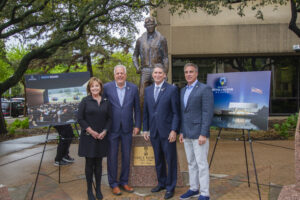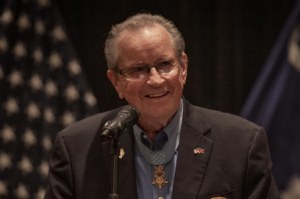A smart guy once said, “All heroes must at last become bores.” As a member of the Congressional Medal of Honor Society, I have known many heroes. Not many of them are bores.
In fact, most of them are very active in their communities on issues involving veterans and our youth. But as a veterans’ society, we were not as organized as, say, the American Legion in our outreach to our youth and veterans. Our conventions were pretty much one big party. I must say, when you party with the likes of Pappy Boynton, Commando Kelly, Scooter Burke and Chief Childress, all world-class partiers, some of us left our conventions with a hangover.
Then one year we went to Philadelphia, where we marched at midnight with the mayor through a ghetto full of drug dealers. The next day, we visited a high school where we actually had to go through a metal detector. Some of us began to wonder if we ought to leave behind something more than a hangover, but we had no resources.
Over the years, society members formed the Medal of Honor Foundation, probably the most powerful foundation in the world in terms of accomplished, well-heeled, patriotic individuals all dedicated to our legacy. They were determined to care for the aging, ailing recipients and their families. And to pass on to future generations the legacy of the Medal – courage, sacrifice and patriotism.
The foundation’s flagship program was the Character Development Program, online and free. Although warriors were central, war was de-emphasized. The key was to teach young people they could be heroes, and they don’t have to go to war to do it. To emphasize this point, the recipients started the Citizen’s Honors program, which annually honors civilian heroes who are examples of the kind of citizens the CDP seeks to inspire. We developed lesson plans, programs of instruction and videos telling the stories of more than 100 recipients who have taken the CDP to hundreds of schools, teachers and thousands of students in every state in the union and some foreign countries.
The recipients are especially effective in inner-city schools, where the students’ retorts to many lecturers was, “You haven’t been were we have.” Well, the recipients have been where they have, and it has an impact on students who see before them an armless, eyeless or legless individual touting the blessings of hard work and sacrifice.
Gen. Brady tells the inspiring, miraculous story of his days as a Dust Off air ambulance pilot in Vietnam. Get his newly reissued book, autographed: “Dead Men Flying: Victory in Viet Nam”
The program also focuses on teaching the importance of courage and sacrifice and especially patriotism. No democratic society will survive if it doesn’t grow patriots, young people who prove they love their country by supporting and defending it. I can think of no better example of patriotism than Webster Anderson. I went into an all-black high school in Chicago where I found a glass case dedicated to Webster, a Medal of Honor recipient from Vietnam. Although they honored Webster, they didn’t know his story, so I told them.
Early one morning in Vietnam, his unit was attacked by communist forces. In the initial attack, they pretty much took off both of his legs – yet he continued to fight. Later, he caught a grenade, and it blew off an arm as he tried to throw it clear of his men.
Still, he fought on. I flew in and picked up what was left of Webster after he had inspired his men to defeat the Communists. Miraculously, the medics saved his life, but his efforts to save his men cost him both legs and an arm, and earned him the Medal of Honor.
Webster and I became close. He thought I saved his life, but it was really the physicians who did. Some years later, we were speaking at a school in Oklahoma. One of the youngsters asked Webster if he would do what he did again, knowing what it would cost him – two legs and an arm. Webster’s answer moves me to this day. He said, “Kid, I only have one arm left, but my country can have it any time they want.”
I am sure those young people will forever be inspired by the words of that great black soldier propped up before them who was as much plastic as he was flesh. Webster’s sacrifice was an investment in their future, and I think some of them realized it for the first time. Webster defined patriotism for those young people, and teaching patriotism should be a top priority of our educational system.
Other recipients have similar stories concerning patriotism as well as courage and sacrifice. Those young people know they are not all born equal in terms of ability or opportunity. Recipients teach them, in the only way that counts, they are all born equal – and that is courage. They can have all the courage they want; you can’t use it up, and it is the key to success in life. And the key to courage is faith, very nearly a universal value of all recipients.
The sacrifices of Medal of Honor recipients have one thing in common: love – love of their fellow troops, their families and their country. True sacrifice is simply love in action, a form of sacrifice that will do nothing for one in a materiel sense, it will only increase their capacity for more sacrifice. The capacity for sacrifice is the essence of leadership, responsibility indeed for happiness itself.
So the message of the Character Development Program to today’s youth – from those who sacrificed their youth that liberty might grow old, over many years and countless battlefields, over the bodies of millions of dead – is that the values of courage founded in faith and sacrifice, based in love, will lead to an incredible capacity for service to others, to patriotism and eventually to the security of America. Peace most certainly is the ultimate victory of all warriors. The CDP secures the values of the Medal of Honor forever. But we needed a vault for those values.
Readers who would like to make a tax-deductible donation to help fund a National Medal of Honor Museum may do so at the National Medal of Honor Museum Foundation website.
Some other great Americans answered the call and founded the National Medal of Honor Museum Foundation to build a National Medal of Honor Museum. It will be a sanctuary for the stories, legacy and contributions of the recipients. It will be unique among all the museums in our country. We have museums focused on wars, like the World War II Museum; on services, like the Air Force Museum; on branches of service, like the Infantry Museum; on functions, like the Air and Space Museum; and even on race. The National Medal of Honor Museum will encompass all wars from the Civil War on, all services, all branches, all functions and all races. Medal of Honor recipients were in every war, in every service, in every branch, in every function; and in every race. This museum will be unique among all the museums of the world.
The museum concept is simple: Inspire and educate. It will focus on the psyche of a young student entering an arena of superheroes wearing dog tags instead of capes. That student will be thrilled with visuals of the selfless grandeur of individual physical courage and sacrifice, the foundation of his freedoms. That student will learn that physical courage can win a battle, but moral courage can change the world.
That student will learn that Medal of Honor recipients not only defended our country, they helped design, develop and enrich it. He will learn that it was a Medal of Honor recipient who first crossed the Atlantic, who first flew in clouds using a gyroscope to open up the skies for all, who founded a great airline, who was the first president of the American Football League, who were great athletes, one a president, members of Congress, mayors, journalists, physicians to presidents, famous actors, governors, generals who fought and won our wars and built our railroads. It was a Medal of Honor recipient who wrote “Taps” and founded the CIA. It was a Medal of Honor recipient who founded Colorado Springs.
That student will see on Mount Rushmore not only great Americans but a Medal of Honor recipient, Theodore Roosevelt, who spoke the motto of the museum: “The lives of true heroism are those in which there are no great deeds to look back on, the little things well done go to make up a successful and truly good life.”
That student will walk out of the museum inspired with the conviction that he, too, can be a hero. He’ll know these men used the same values of courage and sacrifice to excel in combat and also in life. The student will know those same values can be used to excel in his own life. He’ll learn that fear is an emotion, but courage is a decision.
Medal of Honor recipients believe service to our youth is the highest form of patriotism. This museum will be a symbol of patriotism.
G.K. Chesterton said art is the signature of man. This museum will be the signature of all Medal of Honor recipients and the hope they represent for our future. We encourage our readers to join us in building this monument.
Read more at http://www.wnd.com/2016/08/a-monument-to-our-medal-of-honor-heroes/#IheeC8iTmYR5t73W.99

National Medal of Honor Museum Foundation Announces Naming of Colonel Neel Kearby Theater During National Medal of Honor Day Celebration
Museum Foundation leadership partnered with City of Arlington, Texas to pay tribute to local Medal of Honor recipient and kick off Museum’s one-year ‘March to Grand Opening’ countdown .


